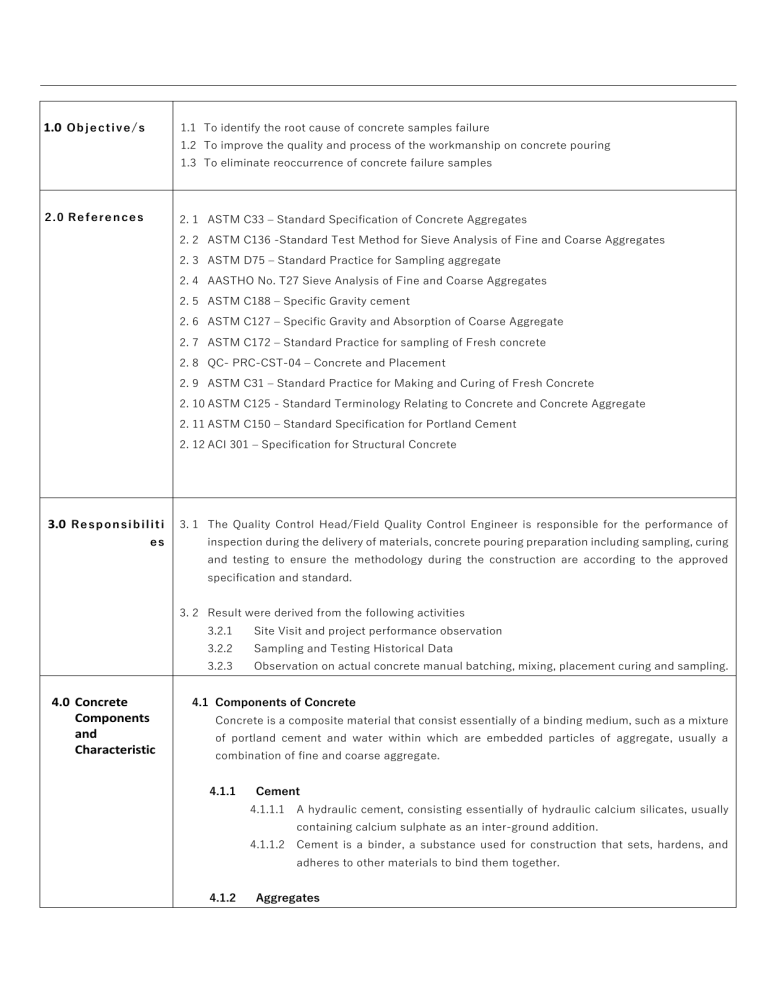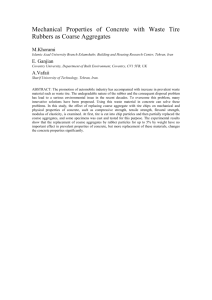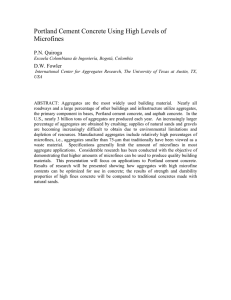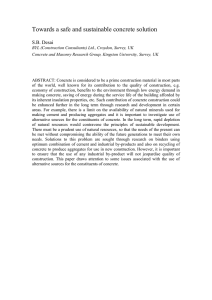
1.0 O b j e c t i v e / s 1.1 To identify the root cause of concrete samples failure 1.2 To improve the quality and process of the workmanship on concrete pouring 1.3 To eliminate reoccurrence of concrete failure samples 2 . 0 Re f e r e n c e s 2. 1 ASTM C33 – Standard Specification of Concrete Aggregates 2. 2 ASTM C136 -Standard Test Method for Sieve Analysis of Fine and Coarse Aggregates 2. 3 ASTM D75 – Standard Practice for Sampling aggregate 2. 4 AASTHO No. T27 Sieve Analysis of Fine and Coarse Aggregates 2. 5 ASTM C188 – Specific Gravity cement 2. 6 ASTM C127 – Specific Gravity and Absorption of Coarse Aggregate 2. 7 ASTM C172 – Standard Practice for sampling of Fresh concrete 2. 8 QC- PRC-CST-04 – Concrete and Placement 2. 9 ASTM C31 – Standard Practice for Making and Curing of Fresh Concrete 2. 10 ASTM C125 - Standard Terminology Relating to Concrete and Concrete Aggregate 2. 11 ASTM C150 – Standard Specification for Portland Cement 2. 12 ACI 301 – Specification for Structural Concrete 1.0 3.0 Re s p on s i b i l i t i 3. 1 The Quality Control Head/Field Quality Control Engineer is responsible for the performance of es inspection during the delivery of materials, concrete pouring preparation including sampling, curing and testing to ensure the methodology during the construction are according to the approved specification and standard. 3. 2 Result were derived from the following activities 3.2.1 Site Visit and project performance observation 3.2.2 Sampling and Testing Historical Data 3.2.3 Observation on actual concrete manual batching, mixing, placement curing and sampling. 1.0 g 4.0 Concrete Components and Characteristic 4.1 Components of Concrete Concrete is a composite material that consist essentially of a binding medium, such as a mixture of portland cement and water within which are embedded particles of aggregate, usually a combination of fine and coarse aggregate. 4.1.1 Cement 4.1.1.1 A hydraulic cement, consisting essentially of hydraulic calcium silicates, usually containing calcium sulphate as an inter-ground addition. 4.1.1.2 Cement is a binder, a substance used for construction that sets, hardens, and adheres to other materials to bind them together. 4.1.2 Aggregates 4.1.2.1 Granular material, such as sand, gravel, crushed stone, or iron blast-furnace slag, used with a cementing medium to form hydraulic-cement concrete or mortar. 4.1.2.2 Two classification of Aggregates are follows: 1. Coarse aggregate (crushed gravel) – aggregate predominantly retained on the 4.75 mm (No. 4) sieve or that portion of an aggregate retained on the 4.75 mm (No. 4) sieve 2. Fine aggregates (sand) – aggregate passing the 3/8 in (9.5 mm) sieve and almost entirely passing the 4.75 mm (No. 4) sieve and predominantly retained on the 75 μm (No. 200) sieve. 4.1.3 Water 4.1.3.1 Any natural water that is potable and low turbidity is satisfactory as mixing water from making or curing concrete. 4.2 Standard Specification of Good Quality of Concrete 4.2.1 Good Quality of Aggregates 4.2.1.1 Coarse aggregate shall be hard, durable crushed rock, natural gravel free from lumps of clay, loam, sticks, acid, alkali, organic matter or other deleterious substances. 4.2.1.2 Fine aggregate shall consist of natural sand, manufactured sand or combination thereof. 4.2.1.3 The amount of deleterious substances in the fine aggregate shall not exceed the limits prescribed in the table below: 4.2.1.4 Coarse Aggregates shall be graded with the following requirements. (See table below Grading Requirements for coarse aggregate from ASTM C33-03). 4.2.1.5 Fine Aggregates shall be graded with the following limits: 4.2.1.6 The fine aggregate shall have not more than 45% passing any sieve and retained on the next consecutive sieve. 4.2.1.7 The particle distribution of coarse aggregate has an influence on workability of concrete, water requirement and ability to be compacted without voids or honeycombs. 4.2.1.8 Most natural coarse aggregates have relative densities (specific Gravity) between 2.4 and 2.9 with corresponding particle (mass) densities of 2400 kg (150 and 181 lb/cuft. 4.2.1.9 The absorption and surface moisture of aggregates should be determined so that the total water content of concrete can be controlled and correct batch weighs determined. 4.2.1.10 Coarse aggregates shall conform to ASTM C-33, AASTHO M80 or Project Specifications. 4.2.1.11 Fine aggregate subjected to five cycles of the soundness test shall have a weighted average loss not greater than 10% when sodium sulfate is used or 15% when magnesium sulfate is used. 4.2.2 Good Quality of Cement (ASTM C 150) 4.2.2.1 4.2.3 Cement to be used shall be type 1, Conforming ASTM C150. Good Quality of Water 4.2.3.1 The mixing water shall be clear and apparently clean. If it contains quantities of substances which contains discoloration or make it smell or taste unusual or objectionable or cause suspicion, it shall not be used unless service records of concrete made with it or other information indicates that it is not injurious to the quality of the concrete. 5.0 Concrete Sa m p l e Breakage Investigation 5.1 Sample 1: CVT B8-04 Date Casted: September 26,2018 Date Tested : October 24,2018 Required Strength: 3000 psi @ 28 days -3/4” Compressive Strength Result: 1670.22 psi Presence of rounded aggregates and larger than the required/maximum size of aggregates Un-even distribution of aggregates on the concrete samples (proof of un-even rodding during concrete sampling). Aggregates subside on the bottom part of concrete Presence of voids Presence of deleterious materials (soil and loose aggregates) Not intact bond between aggregates and cement paste(due to coating of coarse aggregate) 5.2 Sample 2: DS 31- 36B8-04 Footing Date Casted: October 2, 2018,2018 Date Tested : October 30,2018 Required Strength: 300 psi @ 28 days -3/4” Compressive Result: 1887.62psi Presence of rounded aggregates and deleterious materials Pulverize cement paste Presence of honey combs on the concrete sample Presence of deleterious materials and high absorption aggregates Uneven distribution of coarse aggregates with smaller size than required 6 . 0 Re s u l t of 6.1 Poor quality of aggregates Investigation Photos of Coarse aggregate taken at site Fine Aggregates (S1) used at site 6.1.1 The main characteristic of aggregate that affect the performance of fresh and hardened concrete are: • Shape and Texture • Grading • Absorption • Mineralogy and coatings • Maximum size 6.1.2 • Specific Gravity or relative Density • Soundness and Toughness Shape and texture • An excess of poorly shaped particles could reduce the strength of concrete through the increase of water demand. • Flaky, elongated, angular and rough particles have high voids and required more sand to fill voids and to provide workable concrete, thus increasing demand water. • Poorly shaped aggregates may also increase segregation. Concrete made with poorly shaped aggregate requires more cement paste because of the higher voids content. • Texture affects bond between particles and mortar affecting strength and shrinkage. Rough particles tend to provide stronger bond than smooth particles. 6.1.3 Grading • Grading or particle size distribution affects significantly some characteristic of concrete like voids content, workability, segregation and durability. • If fine aggregate is too coarse it will produce bleeding, segregation and harshness but if it is too fine, the demand for water will be increase. (See standard specification of good quality of aggregates below). • Both coarse aggregate and fine aggregate should be uniformly graded. Excess of any size fraction could result in poor workability and in poor durability of concrete. The amounts of coarse and fine aggregate must be in balance. 6.1.4 Absorption • Absorption is the increase in mass of aggregate due to water penetration. • Aggregates with low absorption tend to reduce shrinkage and creep of hardened concrete. • Absorption can be used as an initial indicator of soundness. Photos of high absorption aggregate 6.1.5 Coatings • The layers of material covering the surface of aggregate, can increase the demand for water and can impair the bond between paste and particles. These coatings are formed by materials that can chemically interact with cement, negatively affecting concrete. (Example: Deleterious materials like soil and woods) 6.1.6 Maximum size • A high value of Maximum size of aggregates tends to reduce strength. This can be explained by the observation that bond with large particles tends to be weaker than with small particles due to smaller surface area to volume ratio. • The permeability of concrete increases as the maximum size of the aggregate increases. (See standard specification of good quality of aggregates below). 6.1.7 Specific Gravity or relative density • Low specific gravity may display poor performance. Low permeability is an indicator of poor durability. 6.1.8 Soundness and Toughness • A sound aggregate has a satisfactory durability factor when used in properly mature concrete with enough air void content. • Toughness of aggregate affects abrasion resistance of concrete. • Abrasion test is used to determine the toughness of aggregate. 6.2 No Quality Test Report of Aggregates Delivery Receipt from JLO Hardware & Construction Supply. Tested and Approved Supplier of aggregates were Pacific Conc. Products, Pampanga and Kaulaman River, Floridablanca, Pampanga. 6.2.1 Quality test of aggregates shall perform to identify the characteristic of the aggregates and to have a basis on concrete design mix. (See appendix 6. Example of Quality Test). 6.2.2 The quality of aggregates should be assessed properly in an accepted laboratory, using standard test methods and shall conform ASTM C33. 6.2.3 Quality Test of Aggregates Components: 1. Sieve Analysis grading 2. Specific Gravity Test 3. Absorption Test 4. Unit weight (Bulk Density) 5. Soundness 6. Abrasion Test 7. Maximum size of Aggregates 8. Moisture Content 6.3 Erratic quantity of aggregates on the concrete mixture. Volume of aggregates not correctly measure at site. 6.3.1 Correct proportion and quantity of aggregates plays an important role in achieving a good concrete. Too much or too less quantity of aggregates reduces the strength of concrete. 6.3.2 If the surface area of the aggregate has increased, the water demand also increases. Assuming the water demand has increased, the water cement ratio will increase. Since the water cement ratio has increased, the compressive strength will decrease. 6.4 Usage of un-approve design mix by the client. 6.4.1 Design mix can be defined as the process of selecting suitable ingredients of concrete and determining their relative proportions with the object of producing concrete of certain minimum strength and durability as economically possible. 6.4.2 Using a design mix without a basis (Quality Test of aggregates) have a great impact on the strength of concrete. It produces unpredictable strength of the concrete. 6.5 Excessive/ un-determine water content of the concrete mixture Pale used at site Usage long conveyor/chute may cause of using excessive water content on the concrete mixture. Unaware manpower tends to add more water than required for faster flow of concrete on the conveyor. 6.5.1 One of the factor affecting strength of concrete is water cement/ratio. As the water increases the strength decreases. 6.5.2 Too much water will result in segregation of aggregate components from the cement paste. 6.5.3 Water that is not consumed by the hydration reaction may leave concrete as it hardens, resulting in microscopic pores that means bleeding that will reduce final strength of concrete. 6.6 No slump test apparatus used during concrete pouring. Only Concrete cylinder molds used at site. 6.6.1 Concrete slump test measures the consistency of fresh concrete before it sets. It is performed to check the workability of freshly made concrete. 6.6.2 If slump not specified at design mix Table 6.3.1 from ACI 211.1-91 is recommended: Table from ACI 211.1-91 6.6.3 Slump Test Apparatus Standard size: • Mold (slump cone) – made of metal not readily attacked by the cement paste. The metal shall not be thinner than 0.60 in (1.5mm)The mold shall be in the form of lateral surface of the frustum of a cone with the base 8 in (200 mm) in diameter, the top 4 in (100mm) diameter and the height 12 in (300mm) • Tamping rod –a round, straight steel rod 5/8(16mm) in diameter to a hemispherical tip. 6.7 Defective/substandard tools for concrete sampling (ASTM C31) Oblong shape and defective lock concrete cylinder molds used at site a. Molds- shall be made of steel, cast iron or other non-absorbent material, non-reactive with concrete containing Portland or other hydraulic cement. b. Tamping rod – a round, steel rod with dimensions conforming the below, having tamping end or both ends rounded to a hemispherical tip of the same diameter as the rod. c. Mallet – a mallet with rubber or raw hide head weighing 1.25±.50lbshall be used d. Shovels, hand held floats, scoops shall be provided. 6.8 Unaware on the correct sampling procedure of concrete cylinders 6.8.1 Correct sampling procedure is important because concrete samples represent the structure. 6.8.2 Incorrect sampling tends to reduce the strength of the concrete. Aggregates that were not uniformly distributed along the cylinder mold due to incorrect tamping and rodding can cause voids and air entrapment. ( See ASTM C31 or QC-PRC-CST-04 Concrete and Placement) 7 . 0 Re c om m e n d a t io n 7.1 Good Concrete can be attained by: 7.1.1 Supply of material (cement, aggregates, water) approved with project specification and undergone with careful measure with respect to quality test and standard procedure. 7.1.2 Proper methodology of concrete mixing: 7.1.2.1 Batching material at correct volume/quantity as per approved design mix. 7.1.2.2 Proper mixing with suitable equipment such as maintained cleaned one bagger mixer. 7.1.2.3 Proper methodology of placement of concrete. 7.1.2.4 Proper Curing of poured structure and samples 7.1.3 Sampling and slump testing based on approve quality procedures. 7.1.4 High competency supervisors with knowledgeable and trained manpower on the approved quality procedures. 8 . 0 At t a c h m e n t / Ap p e n d i x 8.1 Concrete Cylinder Testing Monitoring 8.2 Compressive Test Results of Concrete Cylinder Samples 8.3 Design mix and Quality Test of Aggregates approved by NGCP 8.4 Work Request Form for testing of aggregates 8.5 Non-conformance Notice issued by NGCP 8.6 Non-conformity Report at Site 8.7 QC Watch




